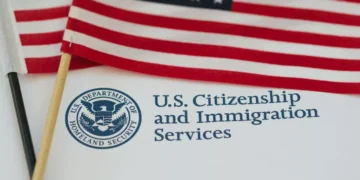No products in the cart.
- The American Side Hustle
- News
- Earning On Social Media
- Finance
- Reviews
- Investing
Trending Tags
- WordPress
- Entertainment
Trending Tags
- Lifestyle
- Tech
- Travel
- Immigration
- Breaking News
- The American Side Hustle
- News
- Earning On Social Media
- Finance
- Reviews
- Investing
Trending Tags
- WordPress
- Entertainment
Trending Tags
- Lifestyle
- Tech
- Travel
- Immigration
- Breaking News
The 2025 Draft: Modernizing Selective Service, Not a Call to Arms
0
SHARES34
VIEWSIn a move aimed at streamlining operations and reducing costs, the Selective Service System (SSS) is set for a significant overhaul in 2025. A recently passed bill has paved the way for automatic enrollment of individuals between the ages of 18-26 into the system, a move that has sparked both intrigue and apprehension.
A Brief History of the Selective Service
Contrary to the alarmist claims circulating online, the Selective Service is not a new concept. It has existed for nearly half a century, quietly fulfilling its mandate to maintain a database of potential draftees in the event of a national emergency requiring rapid military mobilization.
The current system relies on voluntary registration, primarily targeting young men. However, this approach has proven costly and inefficient, necessitating extensive marketing campaigns and reminders to ensure adequate enrollment.
The Rationale Behind Automatic Enrollment
The new legislation seeks to address these inefficiencies by automating the registration process. Upon turning 18, eligible individuals will be automatically enrolled, eliminating the need for extensive outreach efforts.
Importantly, this change does not signal an impending war or a shift in U.S. military policy. Rather, it represents a pragmatic approach to modernizing a critical government function. By streamlining registration, the SSS can significantly reduce its operational costs, saving taxpayer dollars while maintaining a robust pool of potential recruits.
Addressing Misconceptions
The prospect of automatic enrollment has understandably raised concerns among some, who fear it may be a precursor to compulsory military service. However, such fears are unfounded.
The Selective Service is not a draft. It merely maintains a database of potential draftees. In the unlikely event of a draft, individuals would still undergo a selection process, and numerous exemptions and deferments would apply.
Moreover, the U.S. military has repeatedly stated that it has no intention of reinstituting the draft. The current all-volunteer force is more than capable of meeting the nation’s defense needs.
A Necessary Modernization
The 2025 changes to the Selective Service represent a necessary modernization of an outdated system. By embracing automation and reducing reliance on manual processes, the SSS can operate more efficiently and effectively, ensuring it is prepared to fulfill its mission in the unlikely event of a national crisis.
It is important to view these changes through a lens of pragmatism, not fear. The Selective Service is not a harbinger of war but a vital component of the nation’s defense infrastructure. By modernizing its operations, the government can better serve the needs of both the military and the American people.
Stay Connected test
- Trending
- Comments
- Latest
7 best Remote Jobs You Can Start Now to Move to Thailand in 2024
September 5, 2024
The Importance of Writing in SEO and Customer Engagement
March 7, 2025
A Review of ConvertKit: A Powerful Email Marketing Tool
April 24, 2024
The Importance of Writing in SEO and Customer Engagement
March 7, 2025

Tired of the daily grind? Us too. That's why we created The American Side Hustle - your one-stop shop for ditching the cubicle and building a life you love. We dish the daily dirt on making money from home, social media mastery, and even a sprinkle of investing tips (because who doesn't want poolside margaritas funded by the stock market.
Affiliate Disclosure: Here at The American Side Hustle, we're passionate about helping you find the best tools and resources to fuel your side hustle dreams. Sometimes, we'll recommend products or services through affiliate links. This means if you click on one of these links and make a purchase, we may earn a commission at no additional cost to you.
We want to be transparent about our affiliate relationships, but here's the most important thing: our recommendations are always based on our honest evaluation of the product or service. We only recommend products or services that we believe will be genuinely helpful and add value to your side hustle journey.
We appreciate your support! By using our affiliate links, you're helping us continue to create high-quality content and resources for free.
Browse by Category
- Amazon
- Apps
- Art
- Art & Culture
- Art and Culture
- Art and Society
- Arts and Culture
- Beauty
- Beauty and Aesthetics
- Beauty and Culture
- Beauty and Wellness
- Blog
- Blogging
- Blogging and Content Creation
- Blogging Tips
- Breaking News
- Building Custom Functionality
- Building Remote Income Streams
- Building Your Brand
- Business
- Business Development
- Business Services
- Business Solutions
- Business Strategy
- Business Technology
- Career
- Career Advice
- Career Coaching
- Career Development
- Community Engagement
- Community Management
- Content Marketing
- Content Monetization
- Content Strategy
- Cultural Studies
- Culture and Beauty
- Culture and Media
- Current Events
- Digital Marketing
- Digital Nomad
- E-commerce
- E-commerce Essentials
- Earning Money on Social Media
- Eco-conscious Tech
- Economics
- Education
- Email Marketing
- Energy
- Energy & Environment
- Energy and Environment
- Energy and Sustainability
- Entertainment
- Entrepreneurship
- Environment
- Environment and Ecology
- Environment and Energy
- Environment and Sustainability
- Environmental Health
- Environmental Science
- Environmental Studies
- Environmental Sustainability
- Expat
- Expat Life
- Expatriate Life
- Expats
- Fashion
- Finance
- Finance and Economics
- Food
- Food and Travel
- Freelancing
- Freelancing Finances
- Freelancing for WordPress Developers
- Gadget
- Gaming
- Health
- Health & Beauty
- Health & Environment
- Health & Wellness
- Health and Beauty
- Health and Beauty Industry
- Health and Environment
- Health and Wellness
- Home Automation
- Home Technology
- Human Resources
- Immigration
- Immigration Law
- Influencer Marketing
- Infrastructure
- Infrastructure and Development
- Infrastructure Investments
- Investing
- Investing for Remote Earners
- Investment
- Investment & Finance
- Investment and Infrastructure
- Investment Decisions
- Iphone
- Lifestyle
- Live Streaming Strategies
- Location Independent Living
- Marketing
- Marketing Insights
- Marketing Strategies
- Marketing Strategy
- Media and Technology
- Media Studies
- Military
- Military and Defense
- Military and Leadership
- Military and Society
- Military Insights
- Military Operations
- Military Strategy
- Military Studies
- Mobile Phones
- Money Making
- Music
- Music and Emotions
- Music Education
- Music Psychology
- Neuroscience
- News
- News and Society
- Online Business
- Online Community Management
- Performance Optimization
- Personal Development
- Personal Finance
- Personal Growth
- Philosophy
- Philosophy & Art
- Philosophy and Aesthetics
- Philosophy and Art
- Philosophy and Arts
- Philosophy and Communication
- Philosophy and Critical Thinking
- Philosophy and Ethics
- Philosophy and Logic
- Plugin Power
- Policy Power Plays
- Political Analysis
- Political Economy
- Political Science
- Politics
- Politics and Economics
- Premium Content
- Psychology
- Public Health
- Public Policy
- Regulation Revamps
- Regulatory Affairs
- Remote Jobs
- Remote Revolution
- Remote Work
- Remote Work & Taxes
- Remote Work and Digital Nomad Lifestyle
- Remote Work and Entrepreneurship
- Remote Work and Finances
- Remote Work and Technology
- Retirement Planning
- Review
- Reviews
- Sales and Marketing
- Samsung
- Scaling Your Remote Hustle
- Science
- Science & Environment
- Science & Nature
- Science and Education
- Science and Research
- Science and Technology
- Science Communication
- Science Education
- Security and Defense
- Security Shield
- Self-Help
- Self-Help and Personal Development
- Self-Improvement
- SEO
- SEO Strategies
- Side Business
- Side Hustle
- Skills Development
- Social Issues
- Social Issues and Advocacy
- Social Issues and Ethics
- Social Justice
- Social Media
- Social Media Advertising
- Social Media Consulting
- Social Media Influencing
- Social Media Management
- Social Media Marketing
- Social Media Trends
- Social Science
- Social Science Education
- Social Sciences
- Social Selling Techniques
- Societal Development
- Society and Culture
- Society and Media
- Sociology
- Sociology and Cultural Studies
- Startup
- Streaming Insights
- Subsidy Shifts
- Sustainability
- Tax
- Tax Twists & Turns
- Taxation
- Taxation for Remote Workers
- Tech
- Tech Industry
- Technology
- Technology & Infrastructure
- Technology & Media
- Technology & Sustainability
- Technology and Infrastructure
- Technology and Regulation
- Technology and Society
- Technology Industry Insights
- Technology Regulation
- Television
- Television and Film Analysis
- Television Reviews
- The American Side Hustle
- The Digital Nomad's Wallet
- The Future of Social Media Earning
- The Future of WordPress
- The Influencer Economy
- The Remotely Rich Mindset
- The Simpsons
- Theme Talk
- TikTok
- Travel
- Travel & Expatriate Living
- Travel & Food
- Travel & Lifestyle
- Travel & Living
- Travel and Culture
- Travel and Expatriate Living
- Travel and Food
- Travel and Gastronomy
- Travel and Lifestyle
- Travel and Living
- Travel and Personal Development
- Travel and Personal Growth
- Travel Finance
- Travel Tips
- TV Shows
- Urban Development
- Urban Planning
- Veteran Affairs
- Veterans
- Veterans Affairs
- Video Games
- Wearable Technology
- Web Development
- Website Optimization
- Website Security
- WordPress
- WordPress Core
- WordPress Development
- WordPress Insights
- WordPress Plugins
- WordPress Tips
- Work
- Work and Finance
- Work and Lifestyle
- Work From Anywhere Budget Hacks
- Work from Home
- Workplace Culture
- Workplace Trends
- Writing and Communication
- Writing and Marketing
- Zen Business
Recent News
The Importance of Writing in SEO and Customer Engagement
March 7, 2025






















![A Comprehensive Review of [Course/Product/Experience Name] 22 man in gray shirt sitting on black chair](https://theamericansidehustle.net/wp-content/uploads/2025/03/man-in-gray-shirt-sitting-on-black-chair-1-scaled.jpg)













































































